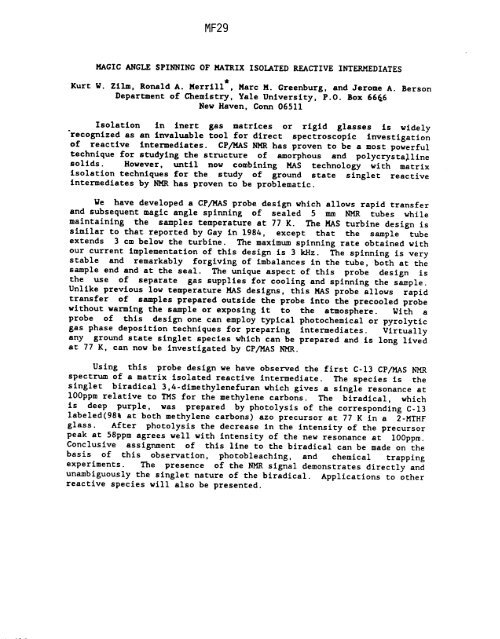th - 1987 - 51st ENC Conference
th - 1987 - 51st ENC Conference
th - 1987 - 51st ENC Conference
You also want an ePaper? Increase the reach of your titles
YUMPU automatically turns print PDFs into web optimized ePapers that Google loves.
MF29<br />
MAGIC ANGLE SPINNING OF MATRIX ISOLATED REACTIVE INTERMEDIATES<br />
Kurt W. Zilm, Ronald A. Merrill , Marc M. Greenburg, and Jerome A. Berson<br />
Department of Chemistry, Yale University, P.O. Box 66~6<br />
New Haven, Corm 06511<br />
Isolation in inert gas matrices or rigid glasses is widely<br />
"recognized as an invaluable tool for direct spectroscopic investigation<br />
of reactive intermediates. CP/MAS NMR has proven to be a most powerful<br />
technique for studying <strong>th</strong>e structure of amorphous and polycrysta~llne<br />
solids. However, until now combining MAS technology wi<strong>th</strong> matrix<br />
isolation techniques for <strong>th</strong>e study of ground state slnglet reactive<br />
intermediates by NMR has proven to be problematic.<br />
We have developed a CP/MAS probe deslgn which allows rapid transfer<br />
and subsequent magic angle spinning of sealed 5 mm NMR tubes while<br />
maintaining <strong>th</strong>e samples temperature at 77 K. The MAS turbine design is<br />
similar to <strong>th</strong>at reported by Gay in 1984, except <strong>th</strong>at <strong>th</strong>e sample tube<br />
extends 3 cm below <strong>th</strong>e turbine. The maximum spinning rate obtained wi<strong>th</strong><br />
our current implementation of <strong>th</strong>is design is 3 kHz. The spinning is very<br />
stable and remarkably forgiving of imbalances in <strong>th</strong>e tube, bo<strong>th</strong> at <strong>th</strong>e<br />
sample end and at <strong>th</strong>e seal. The unique aspect of <strong>th</strong>is probe design is<br />
<strong>th</strong>e use of separate gas supplies for cooling and spinning <strong>th</strong>e sample.<br />
Unlike previous low temperature MAS designs, <strong>th</strong>is MAS probe allows rapid<br />
transfer of samples prepared outside <strong>th</strong>e probe into <strong>th</strong>e precooled probe<br />
wi<strong>th</strong>out warming <strong>th</strong>e sample or exposing it to <strong>th</strong>e atmosphere. Wi<strong>th</strong> a<br />
probe of <strong>th</strong>is design one can employ typical photochemical or pyrolytic<br />
gas phase deposition techniques for preparing intermediates. Virtually<br />
any ground state slnglet species which can be prepared and is long lived<br />
at 77 K, can now be investigated by CP/MAS NMR.<br />
Using <strong>th</strong>is probe design we have observed <strong>th</strong>e first C-13 CP/HAS NHR<br />
spectrum of a matrix isolated reactive intermediate. The species is <strong>th</strong>e<br />
singlet biradical 3,4-dlme<strong>th</strong>ylenefuran which gives a single resonance at<br />
100ppm relative to TMS for <strong>th</strong>e me<strong>th</strong>ylene carbons. The biradical, which<br />
is deep purple, was prepared by photolysis of <strong>th</strong>e corresponding C-13<br />
labeled(98% at bo<strong>th</strong> me<strong>th</strong>ylene carbons) azo precursor at 77 K in a 2-MTHF<br />
glass. After photolysis <strong>th</strong>e decrease in <strong>th</strong>e intensity of <strong>th</strong>e precursor<br />
peak at 58ppm agrees well wi<strong>th</strong> intensity of <strong>th</strong>e new resonance at 100ppm.<br />
Conclusive assignment of <strong>th</strong>is llne to <strong>th</strong>e biradical can be made on <strong>th</strong>e<br />
basis of <strong>th</strong>is observation, photobleachlng, and chemical trapping<br />
experiments. The presence of <strong>th</strong>e NMIR signal demonstrates directly and<br />
unambiguously <strong>th</strong>e singlet nature of <strong>th</strong>e biradical. Applications to o<strong>th</strong>er<br />
reactive species will also be presented.













